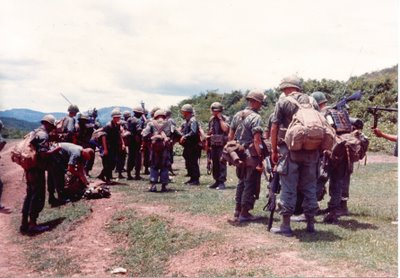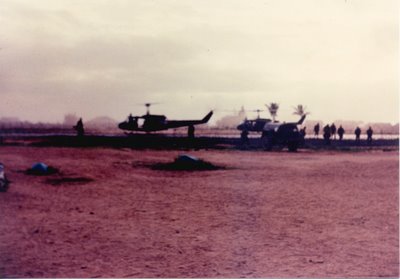Air Strikes and Artillery

As infantrymen, we were on the ground confronting enemy. In Vietnam it was mostly in the countryside and jungles where they hid to prepare plans of attack to ambush or battle us head-on. When we engaged in battles that were especially fierce, we called in artillery and air support from the Navy and Air Force.
Our sergeants and lieutenants radioed coordinates for artillery bombardment when we were pinned down from enemy fire. I remember the sound of shells passing overhead as they landed and exploded in front of us. I didn't understand the coordinates system and physics that enabled artillery pieces a few miles behind us to fire projectiles to explode near without hitting us. Our officers were in radio contact with the rear support units to zero in on the enemy targets.
Many times we had air support. A fixed wing spotter plane circling above called F-4 Phantom or F105 Thunderchief fighter jets from Air Force units at Cam Ranh Bay. I've seen jets many times dive from high above, level out behind us, pass a few hundred feet overhead, release 500 pound bombs or napalm canisters, and pull up to disappear into the sky. Their after-burners blasted the fighter jets upward like a rocket. It was amazing to see. Their armament exploded in the jungle or countryside within a few hundred yards of us.
Napalm's shiny canisters exploded on impact and splashed into unbelievable fireballs. Bombs and napalm were released over our head and behind our positions as momentum carried them on a trajectory to targets toward our front. We could see their free fall through the air as we hunkered on the ground.
As you can tell from the top picture, we were loaded heavy with equipment, radio, ammunition, water, C-rations, claymore mines and hand grenades. There was no space to carry cameras and that was the last thing we needed in battles or the aftermath. Cameras were left in the rear areas. After I snapped the top picture, I handed my camera to the truck driver to take back to the rear.
We never had news reporters with us. I've since heard about famous reporters in Vietnam. I never saw any.
The artillery pieces in the below picture gave us support by firing explosive shells long distances.
The bottom picture shows Huey helicopters delivering combat soldiers to a rear area.
Return here on Sunday, October 1 for an update.
Have a good day!


Labels: Vietnam


0 Comments:
Post a Comment
<< Home